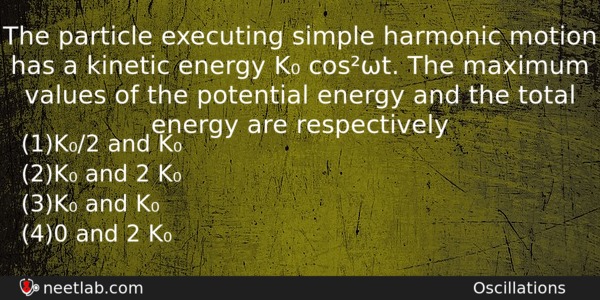| ⇦ | 
| ⇨ |
The particle executing simple harmonic motion has a kinetic energy K₀ cos²ωt. The maximum values of the potential energy and the total energy are respectively
Options
(a) K₀/2 and K₀
(b) K₀ and 2 K₀
(c) K₀ and K₀
(d) 0 and 2 K₀
Correct Answer:
K₀ and K₀
Explanation:
Kinetic energy + Potential energy = total energy
When kinetic energy is maximum, potential energy is zero and vice versa.
.·. Maximum potential energy = total energy
0 + K₀ = K₀
(K.E + P.E = Total energy) .
Related Questions: - A particle of masses m is thrown upwards from the surface of the earth, with a velocity u
- If the ratio of amplitude of two superposed waves is 2:1, then the ratio of maximum
- A thin ring of radius R meter has charge q coulomb uniformly spread on it
- Ice is wrapped in black and white cloth. In which cases more ice will melt
- A deutron is bombarded on ₈O¹⁶ nucleus and α-particle is emitted. The product nucleus is
Topics: Oscillations
(58)
Subject: Physics
(2479)
Important MCQs Based on Medical Entrance Examinations To Improve Your NEET Score
- A particle of masses m is thrown upwards from the surface of the earth, with a velocity u
- If the ratio of amplitude of two superposed waves is 2:1, then the ratio of maximum
- A thin ring of radius R meter has charge q coulomb uniformly spread on it
- Ice is wrapped in black and white cloth. In which cases more ice will melt
- A deutron is bombarded on ₈O¹⁶ nucleus and α-particle is emitted. The product nucleus is
Topics: Oscillations (58)
Subject: Physics (2479)
Important MCQs Based on Medical Entrance Examinations To Improve Your NEET Score
18000+ students are using NEETLab to improve their score. What about you?
Solve Previous Year MCQs, Mock Tests, Topicwise Practice Tests, Identify Weak Topics, Formula Flash cards and much more is available in NEETLab Android App to improve your NEET score.
Share this page with your friends

Leave a Reply